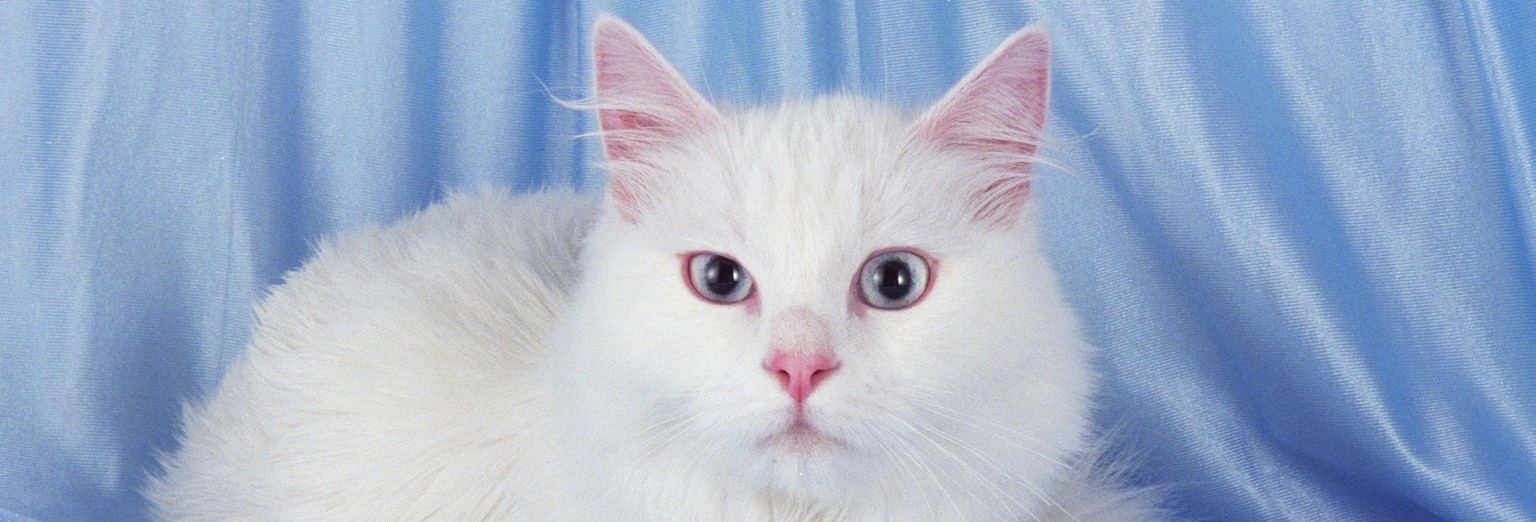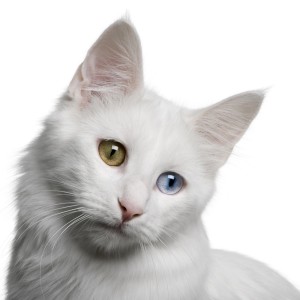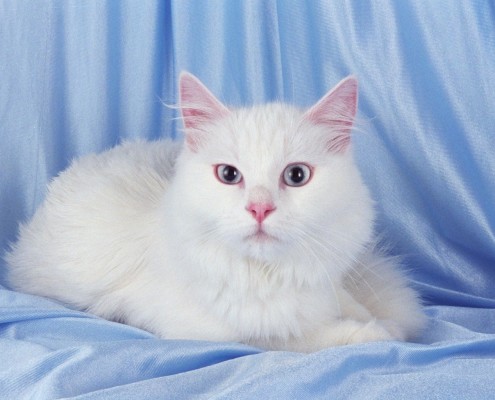Turkish Angora

Meoww!!
The Turkish Angora is a medium-sized, finely boned breed. It has a long, slender torso and neck. The head is small to medium-sized and tapers toward the chin.
In 5 Words
- Outgoing
- Strong-willed
- Affectionate
- Inquisitive
- Intelligent
Snapshot
WEIGHT RANGE:
Male: large: >12 lbs.
Female: 8-12 lbs.
EYE COLOR:
Blue, Copper, Green, Gold, Odd-eyed
EXPECTATIONS:
Longevity Range: 9-14 yrs.
Social/Attention Needs: Moderate
Tendency to Shed: High
COAT:
Length: Medium, Long
Characteristics: Silky
Colors: White, Red, Cream, Black, Blue, Silver, Tortoiseshell, Calico, Dilute Calico, Bluecream
Pattern: Solid Color, Tortoiseshell, Bicolor, Tricolor/Calico, Tabby, Smoke
Less Allergenic: No
Overall Grooming Needs: Moderate
CLUB RECOGNITION:
Cat Association Recognition:
CFA, ACFA , TICA
Prevalence: Rare

Characteristics
Learn About the Turkish Angora
The Turkish Angora cat was imported to Ankara, Turkey by Egyptian traders during the 14th century. The Turkish Angora was recognized as a distinct breed in Europe by the early 17th century. In the early 20th century, the Ankara Zoo, began a meticulous breeding program to protect and preserve what they considered a national treasure: pure white Turkish Angoras. The zoo particularly prized odd-eyed Angoras (i.e., Turkish Angoras with one blue eye and one amber eye), however the cats were chosen only by their color (white)—no other criterion was used. Despite the lack of selective breeding and no consideration given for the deafness problem, Ankara Zoo cats have a very similar type. Turkish Angoras and other longhaired cats where first introduced to Europe in the late 1500s.
The breed came to the United States in the 1700s. The earliest recorded references to the Turkish Angora date back to 16th century France. These cats were well represented in the late 1800s and into the 1900s, during the dawn of the purebred cat fancy in continental Europe and Great Britain. Eventually In 1962 the Ankara Zoo allowed Colonel and Mrs. Walter Grant to have an odd-eyed white male named Yildiz and an amber-eyed white female named Yildizcek. These cats became the foundation of a new breeding program in the USA. 1964 saw Sergeant and Mrs. Ivan Leinbach bring a pair to Arizona: Sam Olgum and Aliya’s Snowball. Mrs. Ray Porter brought a pregnant odd-eyed white female, Belkzar, home with her-the sire of the kittens was one of the Ankara Zoo studs named Sam of Mountain Home.
In 1966 the Grants were able to import another pair: an odd-eyed white male named Mav and an amber-eyed white female named Yaman. Other cats followed in the 1970s and the Turkish Angora became an established breed in North America. With diligent work from this community of Angora fanciers, the breed grew to be numerous enough to be granted registration status with the Cat Fanciers Association (CFA) in 1968, and for provisional competition status in 1970. was accepted as a championship pedigreed breed in 1973 by the Cat Fanciers’ Association. However, until 1978 only white Angoras were recognized. Today, all North American registries accept the Turkish Angora in many colors and patterns. While numbers are still relatively small, the gene pool and base of fanciers are growing.
The Turkish Angora is a medium-sized, finely boned breed. It has a long, slender torso and neck. The head is small to medium-sized and tapers toward the chin. The ears are large, pointed, and tufted, and the eyes are large and almond-shaped. The tail is long and tapering. Unfortunately, often times a Turkish Angora with two blue eyes is deaf. It is stated that if the cat has one blue eye and one green one, it may also be deaf on the side of the head that the blue eye is on. This is not always true though, as many blue-eyed cats can hear perfectly well. The tail is quite pretty and has a plumed appearance. The eyes are almond shaped, and the ears are rather large. The Turkish Angora can weigh as much as eighteen pounds.
The Turkish Angora’s coat is medium-long in length, fine, and silky. It develops a thick coat in the winter, but sheds it in the summer, causing it to look like a short haired breed. Turkish Angoras were originally only accepted in competition if they were white with blue eyes, but they are now accepted in a variety of colors. They are accepted in many colors, excluding the color patterns that indicate hybridization, which are chocolate, lilac, cinnamon, fawn, color point, or Burmese color patterns. The boning must be fine. The silky, fine coat of the Angora changes according to the season; from a short coat with only slight britches and fluffy tail in summer to the full winter coat with medium long, silky hair complete with mane, britches, and lush, plumy tail. The coat must be silky, fine and single with no hint of shagginess.
The Turkish Angora is an affectionate, inquisitive and intelligent companion. They are outgoing, strong-willed and want to be at the very center of their owners’ world. In fact, they seem to expect their owners to be equally interested in what they are doing at any given moment. “Turkeys” can be very opinionated and stubborn; it is difficult to change their minds once they have formed an idea. Those who live with them claim that Turkish Angora cats are one of the only breeds with a well-developed sense of humor. This cat is agile, active and very athletic. The can make a 9 foot jump from a standing position. This cat is very opinionated and stubborn and is not afraid to let you know what it thinks.
They are quick witted and prone to manipulate their owners into doing what they want them to do.However a well-adjusted, properly raised cat will often appear equally friendly to strangers, welcoming them with the level of en-thusiasm which you would be more likely to expect from a dog rather than a cat. Their curiosity and interest in their human companions knows no bounds, few indeed are the household activi-ties that do not benefit from a bit of Turkish Angora assistance. Their intelligence enables them, among other things, to devise ways of opening doors, cabinets and drawers that you would never expect of a cat. Consequently, they often conceal themselves in surprising places. It may be a necessity to search your clothes closet before leaving the house in order to extract the cat playing hide-and-seek there.
The only problems that are documented for the Turkish Angora, occuring at a higher rate than “normal” to other cats, are hormonal and allergic skin complaints*. The hormonal problems are usually resolved with the altering of the cat, and the allergic problems are often responsive to a hypoallergenic diet. Rarely, an allergic problem may be a bit more difficult to treat, requiring medication. Whites are a bit more prone to this, but colors may occasionally experience it as well.
Kinds of health Problem in a Turkish Angora Cat:
Deafness
The same dominant gene that produces this breed’s trademark white coat and blue eyes is responsible for the deafness also characteristic of this breed, according to Petfinder. Genetic hearing loss affects only Turkish Angora cats with blue eyes. In the case of an odd-eyed cat (one with eyes of different colors, which is quite common with this breed) only the ear on the same side as the blue eye will lose hearing function.
Hardened Heart Muscles
In veterinary terms it is referred to as hypertrophic cardiomyopathy. According to Vetstreet it is the most common form of heart disease in cats—including the Turkish Angora. Vetstreet further cautions potential owners of Turkish Angora cats not to fall for any claims by breeders that their line is free of this disease, as it is not possible to guarantee that a cat will not develop hardened heart muscles.
Cancer of the Lymph System
Known technically as lymphosarcoma, the condition is often shortened to “lymphoma” in nontechnical contexts. It is a cancerous infection of the lymph node system containing the lymphocyte cells, which essentially are a type of white blood cell. This lymph system plays a key role in regulating immunity and the body’s response to disease.
Luxating Patella
Luxating patella is caused by a malformation of the knee joint bones, allowing the kneecap to move in and out of position. This is a congenital disease particular to Turkish Angora cats. In severe cases, the kneecap may remain permanently out of joint.
Ataxia
Ataxia is a deadly neuromuscular disease known only to affect Turkish Angora kittens. Symptoms start at about four weeks of age with tremors and a drunken, unsteady gait and rapidly develop into a complete lack of voluntary muscle control. There are three distinct forms of ataxia: cerebellar ataxia is caused by the area of the brain which controls coordination and balance, causing a goose-step type of walk; vestibular ataxia attacks the inner ear and surrounding nerves, which causes a head tilt, walking in circles and frequent falling down; and sensory ataxia, which attacks the brain, spinal cord and surrounding nerves, causing the cat to attempt to balance by standing and walking with their legs splayed. Ataxia may also be the result of an abnormal genetic development of the brain.
Hypertropic Cardiomyopathy
Feline hypertrophic cardiomyopathy, or HMC, is a genetic disease of the heart which causes sections of the heart muscle to harden, interfering with its ability to beat. Symptoms, which may or may not obviously present themselves, may include a lack of appetite, weight loss, gagging or coughing, lethargy and respiratory problems. Cats in an advanced stage of the disease exhibit nasal discharge, shallow panting with their mouths open, and pale gums. Another serious symptom is sudden paralysis of the rear legs, which could indicate a blood clot in the back.
Lymphoma
Lymphosarcoma, or lymphoma, is a cancer involving the cat’s blood and lymphatic system, which is important to the animal’s immune system. Lymph tissues in the spleen, gastrointestinal tract, liver, skin and lymph nodes can be affected. Symptoms include coughing, respiratory problems, vomiting, diarrhea or constipation, weakness and/or loss of appetite. Bloody stool or urine as well as swollen lymph nodes in the neck may be apparent.
Brush the teeth to prevent periodontal disease. Daily dental hygiene is best, but weekly brushing is better than nothing. Trim the nails every couple of weeks. Wipe the corners of the eyes with a soft, damp cloth to remove any discharge. Use a separate area of the cloth for each eye so you don’t run the risk of spreading any infection.
Check the ears weekly. If they look dirty, wipe them out with a cotton ball or soft damp cloth moistened with a 50-50 mixture of cider vinegar and warm water.
Avoid using cotton swabs, which can damage the interior of the ear. Once or twice a week brushing and combing helps to keep the coat glossy and without mats. Luckily,Turkish Angoras fur does not mat easily because of the single coat. Angoras shed more in the summer so brushing and combing needs to be ramped up during the warmers months.They will eat most good quality brands of cat food, and will enjoy treats of chicken, ham and even grated cheese. However, cows’ milk will probably give them a stomach upset, and a bowl of water should always be available.






